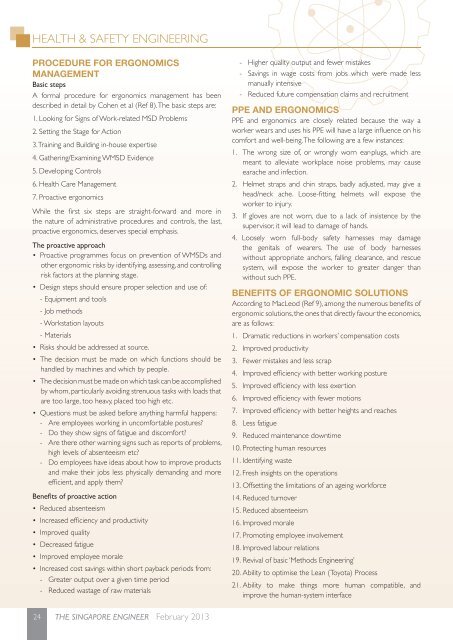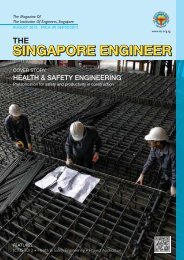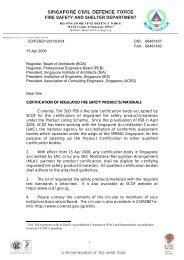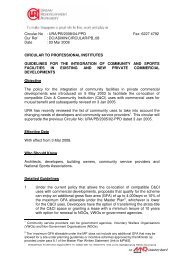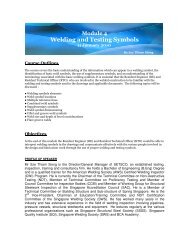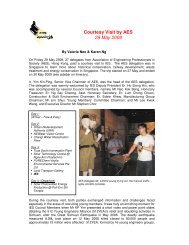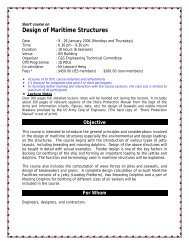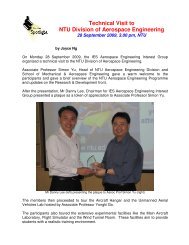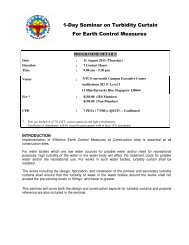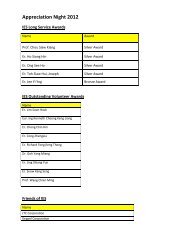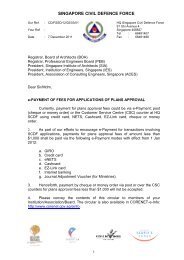civil & structural engineering - Institution of Engineers Singapore
civil & structural engineering - Institution of Engineers Singapore
civil & structural engineering - Institution of Engineers Singapore
Create successful ePaper yourself
Turn your PDF publications into a flip-book with our unique Google optimized e-Paper software.
HEALTH & SAFETY ENGINEERING<br />
PROCEDURE FOR ERGONOMICS<br />
MANAGEMENT<br />
Basic steps<br />
A formal procedure for ergonomics management has been<br />
described in detail by Cohen et al (Ref 8). The basic steps are:<br />
1. Looking for Signs <strong>of</strong> Work-related MSD Problems<br />
2. Setting the Stage for Action<br />
3. Training and Building in-house expertise<br />
4. Gathering/Examining WMSD Evidence<br />
5. Developing Controls<br />
6. Health Care Management<br />
7. Proactive ergonomics<br />
While the fi rst six steps are straight-forward and more in<br />
the nature <strong>of</strong> administrative procedures and controls, the last,<br />
proactive ergonomics, deserves special emphasis.<br />
The proactive approach<br />
• Proactive programmes focus on prevention <strong>of</strong> WMSDs and<br />
other ergonomic risks by identifying, assessing, and controlling<br />
risk factors at the planning stage.<br />
• Design steps should ensure proper selection and use <strong>of</strong>:<br />
- Equipment and tools<br />
- Job methods<br />
- Workstation layouts<br />
- Materials<br />
• Risks should be addressed at source.<br />
• The decision must be made on which functions should be<br />
handled by machines and which by people.<br />
• The decision must be made on which task can be accomplished<br />
by whom, particularly avoiding strenuous tasks with loads that<br />
are too large, too heavy, placed too high etc.<br />
• Questions must be asked before anything harmful happens:<br />
- Are employees working in uncomfortable postures?<br />
- Do they show signs <strong>of</strong> fatigue and discomfort?<br />
- Are there other warning signs such as reports <strong>of</strong> problems,<br />
high levels <strong>of</strong> absenteeism etc?<br />
- Do employees have ideas about how to improve products<br />
and make their jobs less physically demanding and more<br />
effi cient, and apply them?<br />
Benefi ts <strong>of</strong> proactive action<br />
• Reduced absenteeism<br />
• Increased effi ciency and productivity<br />
• Improved quality<br />
• Decreased fatigue<br />
• Improved employee morale<br />
• Increased cost savings within short payback periods from:<br />
- Greater output over a given time period<br />
- Reduced wastage <strong>of</strong> raw materials<br />
- Higher quality output and fewer mistakes<br />
- Savings in wage costs from jobs which were made less<br />
manually intensive<br />
- Reduced future compensation claims and recruitment<br />
PPE AND ERGONOMICS<br />
PPE and ergonomics are closely related because the way a<br />
worker wears and uses his PPE will have a large infl uence on his<br />
comfort and well-being. The following are a few instances:<br />
1. The wrong size <strong>of</strong>, or wrongly worn ear-plugs, which are<br />
meant to alleviate workplace noise problems, may cause<br />
earache and infection.<br />
2. Helmet straps and chin straps, badly adjusted, may give a<br />
head/neck ache. Loose-fi tting helmets will expose the<br />
worker to injury.<br />
3. If gloves are not worn, due to a lack <strong>of</strong> insistence by the<br />
supervisor, it will lead to damage <strong>of</strong> hands.<br />
4. Loosely worn full-body safety harnesses may damage<br />
the genitals <strong>of</strong> wearers. The use <strong>of</strong> body harnesses<br />
without appropriate anchors, falling clearance, and rescue<br />
system, will expose the worker to greater danger than<br />
without such PPE.<br />
BENEFITS OF ERGONOMIC SOLUTIONS<br />
According to MacLeod (Ref 9), among the numerous benefi ts <strong>of</strong><br />
ergonomic solutions, the ones that directly favour the economics,<br />
are as follows:<br />
1. Dramatic reductions in workers’ compensation costs<br />
2. Improved productivity<br />
3. Fewer mistakes and less scrap<br />
4. Improved effi ciency with better working posture<br />
5. Improved effi ciency with less exertion<br />
6. Improved effi ciency with fewer motions<br />
7. Improved effi ciency with better heights and reaches<br />
8. Less fatigue<br />
9. Reduced maintenance downtime<br />
10. Protecting human resources<br />
11. Identifying waste<br />
12. Fresh insights on the operations<br />
13. Offsetting the limitations <strong>of</strong> an ageing workforce<br />
14. Reduced turnover<br />
15. Reduced absenteeism<br />
16. Improved morale<br />
17. Promoting employee involvement<br />
18. Improved labour relations<br />
19. Revival <strong>of</strong> basic ‘Methods Engineering’<br />
20. Ability to optimise the Lean (Toyota) Process<br />
21. Ability to make things more human compatible, and<br />
improve the human-system interface<br />
24 THE SINGAPORE ENGINEER February 2013


